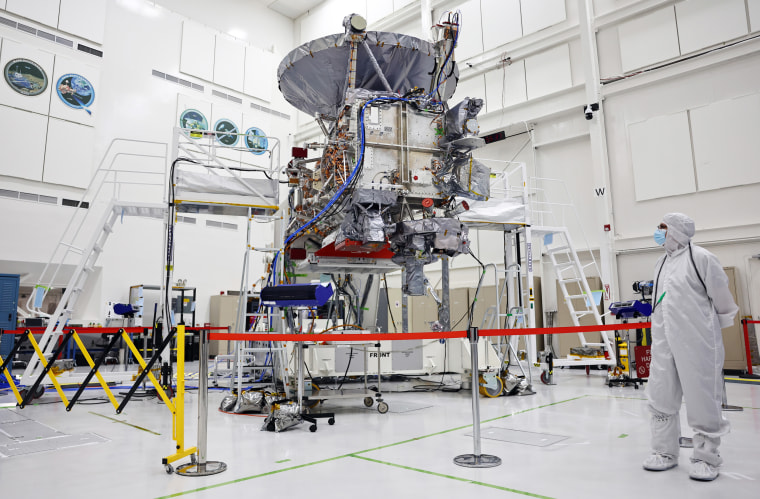NASA’s groundbreaking Europa Clipper spacecraft, on its ambitious journey to Jupiter’s icy moon Europa, has successfully begun deploying its scientific instruments. This mission marks a pivotal step in exploring the possibility of extraterrestrial life within our solar system. Launched on October 14, 2023, aboard SpaceX’s Falcon Heavy rocket from Kennedy Space Center, the Europa Clipper is now well into its 1.8-billion-mile voyage to study Europa, believed to harbor a subsurface ocean beneath its icy crust.

A Historic Spacecraft On A Groundbreaking Journey
As of now, the Europa Clipper has traveled over 13 million miles (20 million kilometers) since its launch, moving at an impressive 35 kilometers per second relative to the Sun. According to NASA, the spacecraft is equipped with a suite of advanced scientific instruments aimed at studying Europa’s magnetic field, icy surface, and the subsurface ocean believed to lie beneath. This ocean is of particular interest as it could provide conditions suitable for supporting life.
Instrument Deployment Begins Successfully
The deployment of the probe’s science instruments marks a major milestone. Among the first instruments to be deployed is the spacecraft’s magnetometer, which is attached to an 8.5-meter boom. The magnetometer is crucial for measuring Europa’s magnetic field and will play a vital role in confirming the existence of an underground ocean. It will also provide critical data on the ocean’s depth and salinity, adding to our understanding of this mysterious moon.
Additionally, NASA reports that the spacecraft has extended several radar antennas as part of the Radar for Europa Assessment and Sounding: Ocean to Near-surface (REASON) instrument. These antennas, including four high-frequency antennas measuring 17.6 meters each and eight smaller antennas, will analyze Europa’s icy crust and help scientists understand the moon’s geological features.
Jordan Evans, project manager for the Europa Clipper mission at NASA’s Jet Propulsion Laboratory, explained that the deployment process is being meticulously monitored. Engineers are receiving data from the spacecraft to ensure that the instruments are functioning correctly and behaving as expected.

Innovative Technology To Uncover Europa’s Secrets
The Europa Clipper mission is pioneering in its approach. Its deployment of precision radar and magnetic field measurements is expected to offer unprecedented insights into Europa’s subsurface ocean, a region shrouded in mystery. The use of high-frequency radar antennas will enable the spacecraft to simulate natural phenomena like solar eclipses, providing a clearer picture of the moon’s icy crust and its interaction with the ocean below.
The spacecraft also features thermal imaging technology that will allow scientists to study Europa’s surface temperatures and detect potential areas of geological activity. These instruments aim to answer the age-old question: can Europa’s environment sustain life?
Milestones Leading To Jupiter
NASA has outlined several key milestones for the Europa Clipper mission before it reaches Jupiter in 2030. One of the most significant upcoming events is the gravity-assist maneuver around Mars scheduled for March 2025. This maneuver will test some of the spacecraft’s instruments and provide thermal imaging data of the Red Planet.
Another gravity assist will occur around Earth in December 2026, which will help refine the spacecraft’s trajectory toward Jupiter. This phase will also involve calibrating instruments like the magnetometer, ensuring they are fully functional for the critical flybys of Europa.
The Europa Clipper spacecraft, the largest ever built for a planetary mission, is expected to conduct 49 flybys of Europa beginning in 2031. These flybys will collect invaluable data about the moon’s surface, its magnetic field, and the underlying ocean, providing humanity with its most detailed look yet at one of Jupiter’s most enigmatic moons.
What This Means for Space Exploration?
NASA’s Europa Clipper mission represents a leap forward in the search for life beyond Earth. The data it gathers will help scientists determine whether Europa’s icy surface conceals a habitable environment, potentially expanding our understanding of where life can exist in the universe.
Moreover, the mission underscores the growing role of international collaboration in space exploration. With the European Space Agency (ESA) contributing to the mission, scientists from both NASA and ESA will benefit from the data, fostering advancements in solar system research and space technology.
A Look Ahead
As the Europa Clipper continues its journey, anticipation builds for the groundbreaking discoveries it promises to deliver. With its state-of-the-art instruments and ambitious mission objectives, the spacecraft stands at the forefront of NASA’s efforts to unlock the secrets of our solar system.
The Europa Clipper is not just a mission—it’s a testament to humanity’s relentless pursuit of knowledge and the dream of exploring worlds beyond our own. Whether Europa harbors the conditions necessary for life remains to be seen, but one thing is certain: the Europa Clipper is bringing us closer to answering some of the most profound questions about our place in the universe.

